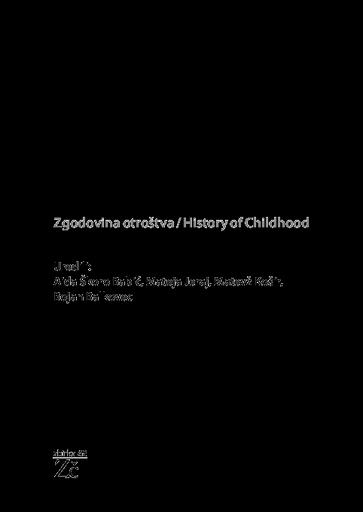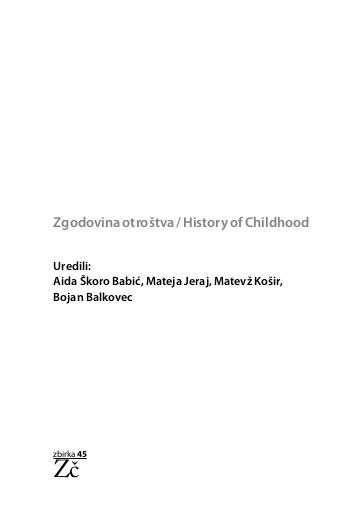/
Literature
/
Monographs
School for Deaf Children in Ljubljana, 1919–1940

Author(s):Dunja Dobaja
Co-author(s):Peter Štih (gl. in odg. ur.), Aida Škoro Babić (ur.), Mateja Jeraj (ur.), Matevž Košir (ur.), Bojan Balkovec (ur.)
Year:2012
Publisher(s):Zveza zgodovinskih društev Slovenije
Source(s):Zgodovina otroštva
Language(s):slovenščina
Type(s) of material:text
Keywords:gluhonemnica,, glasovni govor, gluhonemi otrok, school for deaf children, deaf children, voice speaking
Collection(s):Zbirka zgodovinskega časopisa, 45
Rights:

This work by Dunja Dobaja is licensed under Creative Commons Attribution-NonCommercial-NoDerivs 4.0 International
Files (1)

Name:Zgodovina_otrostva.pdf
Size:10.87MB
Format:application/pdf
Permanent link:https://hdl.handle.net/11686/file17925
Description
Author presents a school for deaf children in the between the wars period, when this school had to deal with overcrowding and lack of financial resources, because of that the leadership of the institution was not in the position to accept all the deaf children that applied for it. Enrolled children got an education by vocal method, they were educated for a profession and with that they got an opportunity for independent life. The article focuses mainly on deaf children at a lower school level and describes teaching in the preparatory class.
Metadata (13)
- identifierhttps://hdl.handle.net/11686/31046
- title
- Gluhonemnica v Ljubljani 1919−1940
- School for Deaf Children in Ljubljana, 1919–1940
- creator
- Dunja Dobaja
- contributor
- Peter Štih (gl. in odg. ur.)
- Aida Škoro Babić (ur.)
- Mateja Jeraj (ur.)
- Matevž Košir (ur.)
- Bojan Balkovec (ur.)
- subject
- gluhonemnica,
- glasovni govor
- gluhonemi otrok
- school for deaf children
- deaf children
- voice speaking
- description
- Avtorica predstavi šolo za gluhoneme otroke v obdobju med obema vojnama, ko se je omenjeni zavod spopadal s prostorsko stisko in pomanjkanjem finančnih sredstev, kar je vodstvu zavoda onemogočalo sprejetje vseh prijavljenih gluhonemih otrok. Sprejeti otroci pa so bili deležni pouka po vokalni metodi, izučitve poklica in s tem možnosti za kasnejše samostojno življenje. Prispevek se osredotoča predvsem na gluhoneme otroke na nižji stopnji in podrobneje opiše pouk v pripravljalnem razredu.
- Author presents a school for deaf children in the between the wars period, when this school had to deal with overcrowding and lack of financial resources, because of that the leadership of the institution was not in the position to accept all the deaf children that applied for it. Enrolled children got an education by vocal method, they were educated for a profession and with that they got an opportunity for independent life. The article focuses mainly on deaf children at a lower school level and describes teaching in the preparatory class.
- publisher
- Zveza zgodovinskih društev Slovenije
- collection
- Zbirka zgodovinskega časopisa, 45
- date
- 2012
- type
- besedilo
- language
- Slovenščina
- isPartOf
- rights
- license: ccByNcNd
Citirano v (3)
| Tipologija | Avtor(ji) | Naslov | Kraj | Založba | Leto |
|---|---|---|---|---|---|
| 1.02 Pregledni znanstveni članek | Dobaja, Dunja | Ignacij Holzapfel, župnik in dekan v Ribnici, dobrotnik gluhoneme mladine : ustanovitev ljubljanske gluhonemnice in ohranjanje spomina na Ignacija Holzapfla | Ljubljana | Zveza zgodovinskih društev Slovenije | 2018 |
| 1.16 Uvodnik, predgovor, spremna beseda | Dobaja, Dunja | Izobraževanje in integracija gluhih v Sloveniji v obdobju med obema vojnama – pot iz revščine | Ljubljana | Inštitut za novejšo zgodovino | 2022 |
| 2.01 Znanstvena monografija | Dobaja, Dunja | Gluhi in svet : med odrinjenostjo in vključenostjo | Ljubljana | Inštitut za novejšo zgodovino | 2024 |
